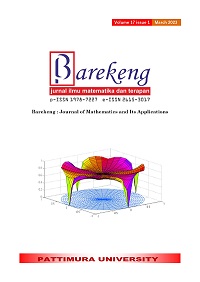ANALYSIS OF ROBUST CHAIN LADDER METHOD IN ESTIMATING AUSTRALIAN MOTOR INSURANCE RESERVES WITH OUTLYING DATASET
Abstract
Reserves are one of the most crucial components for an insurance company to make sure it has enough money to pay off all the incurred claims. The presence of outliers in the incurred claims data harbors risk on inaccurately predicting reserves to cover claim amounts, usually achieved by the standard chain ladder reserving method. To remedy the effect of the outliers, the robust chain ladder reserving method is used by setting the median value to predict estimated reserve. On this research, we utilized both methods on various datasets. The purpose of this paper is to determine the best method that can be utilized by insurance company in various scenario to obtain the most optimized reserved estimate that can minimize the risk of being unable to pay the insurance claim or even the risk of over allocating reserves that could pose profitability issue. The primary data used are the Australian domestic motor insurance claims from 2012 to 2017, obtained from Australian Prudential Regulation Authority (APRA). The dataset is then manipulated to have outliers. After calculating the estimation, the result is compared to assess the strength of the methods using Mean Squared Error (MSE) and Root Mean Squared Error (RMSE) calculation. In conclusion, we found that the robust chain ladder reserving method works better in an outlying dataset. We also identify cases in which robust chain ladder are not appropriately used.
Downloads
References
T. Mack, “Distribution-free calculation of the standard error of chain ladder reserve estimates,” ASTIN Bull., vol. 23, no. 2, pp. 213–225, 1993.
S. A. et al Klugman, Loss Models: From Data to Decisions, 5th ed. John Wiley & Sons, 2019.
M. Barlak, J.; Bakon, M.; Rovnak, M.; Mokrisova, “Heat Equation as a Tool for Outliers Mitigation in Run-Off Triangles for Valuing the Technical Provisions in Non-Life Insurance Business,” Risks, vol. 10, no. 9, p. 171, 2022.
B. Avanzi, B.; Lavender, M.; Taylor, G.; Wong, “On the impact detection and treatment of outliers in robust loss reserving,” Proc. Actuar. Institute, Gen. Insur. Semin., pp. 13–15, 2016.
Ö. Hubert, M.; Verdonck, T.; Yorulmaz, “Fast robust SUR with economical and actuarial applications,” Stat. Anal. Data Min. ASA Data Sci. J., vol. 10, no. 2, pp. 77–88, 2017.
J. Verdonck, T.; Wouwe, M. V.; Dhaene, “A robustification of chain ladder method,” North Am. Actuar. J., vol. 13, no. 2, pp. 280–298, 2009.
B. Pitselis, G.; Vasiliki, G.; Ioannis, “Robust loss reserving in a log-linear model,” Insur. Math. Econ., vol. 64, pp. 14–27, 2015.
Y. Suwardi; D.A.; Purwono, “The Analysis of Motor Vehicle Insurance Claim Reserve Using Robust Chain Ladder,” 5th Glob. Conf. Business, Manag. Entrep. (GCBME 2020), 2021.
M. Schoepf, “On The Double Chain Ladder for Reserve Estimation with Bootstrap Applications,” Missouri University of Science and Technology, 2016.
T. Peremans, K.; Aelst, S. V.; Verdonck, “A Robust General Multivariate Chain Ladder Method,” Risks, vol. 6, no. 4, p. 108, 2018.
G. Taylor, Loss Reserving An Actuarial Perspective, 1st ed. New York: Springer, 2000.
L. R. Brown, R. L.; Gottlieb, Introduction to Ratemaking and Loss Reserving for Property and Casualty Insurance. Winsted: ACTEX Publications, Inc, 2007.
R. J. Beaver, B. M.; William Mendehall, I.; Beaver, Introduction to Probability and Statistics, 14th ed. Boston: Brooks/Cole, 2013.
Y. A. Warton, D. I.; Thibaut, L.; Wang, “The PIT-trap—A ‘model-free’ bootstrap procedure for inference about regression models with discrete, multivariate responses,” PLoS One, vol. 12, no. 7, p. e0181790, 2017.
APRA, “General insurance claims development statistics,” Australian Prudential Regulation Authority, 2021.
Copyright (c) 2023 Jonathan Prasetyo Johan, Felivia Kusnadi, Benny Yong

This work is licensed under a Creative Commons Attribution-ShareAlike 4.0 International License.
Authors who publish with this Journal agree to the following terms:
- Author retain copyright and grant the journal right of first publication with the work simultaneously licensed under a creative commons attribution license that allow others to share the work within an acknowledgement of the work’s authorship and initial publication of this journal.
- Authors are able to enter into separate, additional contractual arrangement for the non-exclusive distribution of the journal’s published version of the work (e.g. acknowledgement of its initial publication in this journal).
- Authors are permitted and encouraged to post their work online (e.g. in institutional repositories or on their websites) prior to and during the submission process, as it can lead to productive exchanges, as well as earlier and greater citation of published works.






1.gif)



